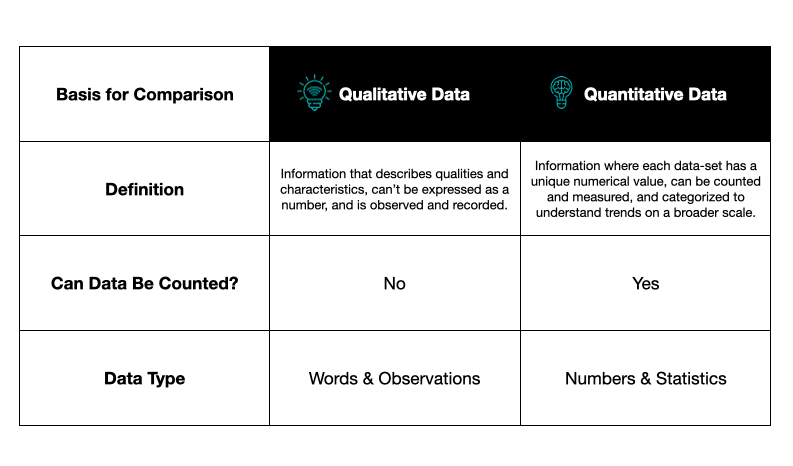When it comes to marketing, because everything is digital and trackable, it’s easier to understand impact than ever before. Engagement rates, CPC (cost per click), CPM (cost per thousand impressions), conversion rates on your website, CPL (cost per lead), LTV (lifetime value per customer) – the list goes on and on. The ability to track such data has changed the marketing game, it’s given marketers the information they need to make more informed decisions and give business leaders a sense of progress when it comes to marketing.
The investment in analytics solutions proves this: business revenue for analytics solutions was set to reach $200 billion in 2020, with double-digit annual growth through 2022.
But with all of this information available at our fingertips, it’s almost driven marketers to stop talking to customers and solely rely on the information on the screen. We’ve seen it, We’ve done it.
There are two big issues with only relying on quantitative information in marketing: 1. A lot of the time, the things that have an impact can’t be tracked to an ROI, and 2. The quantitive data lacks the qualitative overlay, the context in which user decisions were made.

If you are running a marketing team, or you’re just trying to build your business generally, pairing the qualitative with any quantitative data is the best way to understand the impact of your marketing. But how should one go about measuring the qualitative? And better yet, how does one communicate that impact to stakeholders, teammates, and others?
We break it down in a few ways:
Look for Qualitative Signals Proactively
- Qualitative signals could mean a lot of things, but they’re usually reactively discovered – someone shares anecdotal feedback in a conversation, they shoot you a nice comment over social media, or they respond to the email. The key to gathering the right qualitative information to shape your marketing is to be proactive about it. To do this is simple – ask your clients regularly what they want to hear about from you, where, when, and in what form. Whether you’re asking them to fill out a survey or asking them a series of questions at the end of a quarterly meeting – being proactive enables you to be intentional with the feedback shared. Penny Phillips of Journey Strategic Wealth, for example, started marketing her business by developing videos around the biggest questions she would receive from clients. Nothing complex about it, rather talking about things that were top of mind for the people who cared about them. We recommend that advisors ask ten or more clients a series of twelve questions. Once you gather this information, it essentially shapes your marketing strategy for you.
- Another way to collect qualitative data: customer surveys. Usually, people think of larger datasets when it comes to customer surveys, the construct of a survey often lends itself better to quantitative results. This is where open-ended questions come in. Sending out a survey to all of your clients, or a subset of your clients can give you larger scale feedback in a shorter amount of time. It’s important to keep some of the questions open-ended to gather qualitative feedback.
Use Those Signals to Test Trackable Tactics
- Collecting the feedback is one thing, using it to fuel your large marketing efforts is another. Qualitative data often gets a bad rap due to its scalability, because one client or group shares specific feedback, doesn’t mean everyone you’re going after feels the same. But using qualitative feedback in your marketing and measuring more quantitative metrics enables you to look across all of your audience sets and understand if messages, content, and tactics have mass appeal or not.
- How can you test the qualitative feedback tactically? Whether it’s inspiring your content strategy, influencing your email headlines, or informing how you position yourself on your website –use the feedback you receive to change how you operate marketing-wise. As you’re making these tactical changes, the quantitative will then show you whether these tweaks have broader applications. Inbound leads, email engagement rates, close rates on prospects – these are the metrics you should measure based on the changes you make relating to the feedback you receive.
When Collecting, Remove ego, and be Direct
- Most people don’t proactively seek constructive feedback, but uncomfortable situations allow you to grow as a financial advisor. When collecting this qualitative data, you must remove ego from the experience and ask direct questions – there may be information shared that you don’t want to hear, and there may be some suggestions made that mean heavier investments into certain areas. Having these, oftentimes, uncomfortable conversations will allow your business to shape itself, it will enable your roadmap to develop naturally, but if you allow ego to play a factor or tiptoe around certain questions – you’ll only find what you want to find, which often can be an echo chamber that leaves you stalled.
The Bottom Line
Good marketing is a mixture of push and pull tactics, it’s also a mixture of understanding your marketing data, while proactively taking time to understand the context behind the data. This often begins with one step: collecting qualitative feedback.

